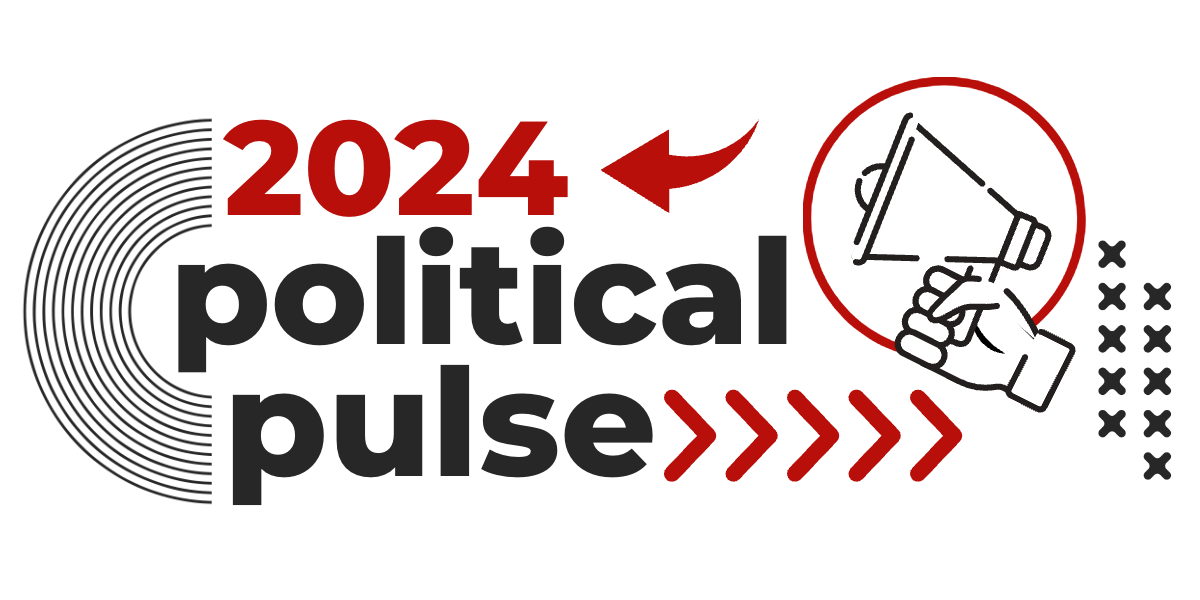DATA POINTS
- 7.5%: The average U.S. 30-year fixed mortgage rate – the highest it’s been since 2000
- 26: The number of federal laws waived by the Biden Administration to continue border wall construction in South Texas
- 60%: The approximate percentage of Americans who think companies should not take a stand on controversial political or social issues
- 1,330: The current total of workers laid-off by Ford due to the UAW strike
- 49%: The percentage of employees who are happy with their current job
- 750,000: The number of Kaiser Permanente workers on strike; the largest healthcare strike in history
 The Battleground Demographic Grows
The Battleground Demographic Grows
34.5 million Hispanic Americans will be eligible to vote in the 2024 election – a staggering 4.7 million increase since 2018. As more Latinos turn 18, that number will only continue to grow, and young Latinos are eager to show up at the polls. Nevada and Arizona, notoriously contentious battleground states, saw a massive wave of Latino voters in the past election. While the demographic turns out to the polls, they could not be further from forming a bloc. In 2022, 60% of them voted blue and 39% voted red.
For many Hispanic voters, their main concerns are economic – their families are hurting with gas prices, rising food costs, and stagnant wages. For some, firearm regulation and other social issues are paramount, while for others, the military, police treatment of their communities, and religion are top priorities. Geography has a significant role to play, too, especially given how Latino populations are found in every corner of the country. Latinos in California, Texas, and the rest of the Southwest tend to be liberal. Those in Florida, predominantly with Cuban heritage, tend to vote Republican. While many Hispanic Americans with Mexican heritage hail from highly religious families, Protestants tend to vote Republican and Catholics tend to vote Democrat.
The bottom line: There is no such thing as a “Latino Vote.” For a presidential or Congressional candidate hoping to secure Hispanic American support, the only path to winning them over is hearing their concerns firsthand.
McCarthy Made History, but Not How He Intended
Former Speaker of the House Kevin McCarthy is officially the first person in U.S. history to be ousted from the number 3 position in U.S. Government. How did this happen? The same far-right Representatives (all members of the Freedom Caucus) who caused road bumps in McCarthy’s election to the post last January were the cause of his downfall. His intra-party critics seized on McCarthy pushing through a temporary funding bill without any reductions in order to prevent a government shutdown. Rep. Matt Gaetz of Florida exercised the motion to vacate the chair, triggering a vote with all voting Democrats and eight Freedom Caucus Members removing McCarthy from his leadership position.
So now, with McCarthy out as Speaker, Representative Patrick McHenry – the bespectacled and bowtie-laden Republican from North Carolina who chairs the House Financial Services Committee – is serving as interim Speaker of the House until Republicans can unify themselves behind a new candidate. McHenry will oversee the chamber in the near term and will preside over the coming election of a new Speaker of the House (second in line of succession to the Presidency).
The Speakership is a heavy and often thankless position. McCarthy is not the first to face the fires of removal. Republican Speaker Joseph Cannon confronted his critics head-on, calling their bluff, and set the vote for his ousting himself. He survived that vote that took place over 100 years ago. In 2015, Speaker John Boehner faced similar pressure. While the threat against him never made it to a vote, it led him to announce an early retirement.
As GOP presidential hopefuls continue to hit the campaign trail, House Republicans are in disarray among the in-fighting, and it remains unclear who the next Speaker will be. As of now, two high profile figures are pursuing the gavel: House Majority Leader Steve Scalise of Louisiana and House Judiciary Chair Jim Jordan. Both strong conservatives, but stylistically very different. More on that next week.
Read More at the Associated Press
Jack Be Nimble, Jack Be Quick. Jack Can’t Decide to Stay or Quit.

A post-pandemic workforce has demanded an increased life-work balance, remote and hybrid opportunities, better pay, and passion-aligned careers. During the Great Resignation, employers upped their game to entice new applicants. Therefore, this shift indicates that people keeping their jobs has less to do with the economy and more to do with worker happiness. Data from the Conference Board shows that workers are happier than they’ve been in 36 years (don’t drop the balloons just yet. Only 49% say they are happy in their job).
But there’s another side to every coin.
Job growth has cooled over the past few years and job postings are down 15% from a year ago according to Indeed, despite worker demand holding strong. Furthermore, the worker happiness trends may not persevere into the immediate future. As job growth cools, so too will wage growth; it will be harder to negotiate for a big raise. To top it off, 90% of companies also plan to implement return-to-office policies by the end of 2024.
As British philosophers The Clash once posited, “should I stay or should I go now? If I go there will be trouble. And if I stay, it will be double.”
Read More at The Wall Street Journal
Butler Ready to Serve California

But who is Laphonza Butler? And how did she come to be appointed?
A close friend and premier donor to Vice President Kamala Harris, Senator Butler has a long history working in public relations, communications, and political campaigns. She is known as a strong advocate for abortion rights – the first Black woman to be president of EMILY’s List, a PAC that seeks to elect democratic, pro-choice women to positions of power.
And while her appointment has generated accolades from leaders ranging from Vice President Harris to NAACP President and CEO Derrick Johnson, not all have jumped on the Butler bandwagon.
One of Butler’s final acts as president of EMILY’s List laid off some staffers – something employees felt as a betrayal to her pro-worker background. Others are frustrated over her connections to businesses in Silicon Valley that could be seen as less than labor-friendly, like Airbnb, which some claim is making houses more expensive, and Uber. Butler also faced heat for moving to Maryland for her role as president of Emily’s List two years ago, though she moved back to Los Angeles upon her appointment.
Senator Butler has not yet stated her intentions on whether or not she will run to keep the seat. If she does, she will have less than one year to make her case for staying in the Senate. Representatives Barbara Lee, Katie Porter, and Adam B. Schiff have each confirmed they are running for what they expected to be an open seat. If she decides to run, she would have the power of incumbency, but would start off well behind her rivals in campaign fundraising and key endorsements.
The Slow Knife is the Deadliest

Life expectancy in the U.S. is low compared to similar countries, and it seems to be getting worse. Declining overall health in the U.S., increasing obesity rates, and problems in the healthcare system have driven up death rates for decades. As a result of this issue, people tend to fear going to the doctor, or even the hospital, when health issues arise. The high COVID death rates in the U.S. proved this even further and has caused other health issues to fall behind.
Death rates are also increasing when it comes to class and racial divides. In the early 1980s, people in the poorest areas of the country were 9 percent more likely to die each year, with 88 more deaths per 100,000 people. Today, that number has eclipsed 61%. Additionally, once-healthy rural communities have significantly lower life expectancies than their urban counterparts.
Read More at The Washington Post
Underfunded Technology in the Classroom

The problem? It’s expensive and funds are drying up.
During COVID, edtech school budgets were increased by $189.5 billion in relief funds. The results: in 2019, U.S. school districts accessed an average number of 895 edtech tools. In 2020, that number jumped to 2,263 as classes went remote. Now, the imminent expiration of these funds will create a $1,200 deficit per student. As with all of the technological incorporation COVID brought with it, the cat is out of the bag. So, schools need to decide whether or not to continue these programs by requiring parents to opt-in to their use. This will create a scenario where some students have access to premier learning opportunities, while others do not.
If underfunded access to these tools is a problem, student data safety is another concern entirely. The intersection between ensuring students are funded for access to meaningful tech education and ensuring their privacy remains an important issue to fix for the future of education in the U.S.
INTERNATIONAL SPOTLIGHT
Pope Francis Hears the Voices of the Flock
October will be a big month for Catholics worldwide as Pope Francis gathers the Synod of Bishops from Oct. 4 through 29. The agenda will provide an opportunity for Catholic leadership to consider the future of the religious organization. The purpose of this meeting is to stimulate debate and ask more questions than give answers.
The docket includes developing concrete steps to promote women to decision-making positions, including becoming deacons, and for the ordinary churchgoers to have more say in Church governance. Bishops will also consider “radical inclusion” of Catholics identifying as LGTBQ+. This piece is especially important for the U.S.: there are 1.3 million LGBT Roman Catholics in the country alone.
This meeting has been a long time coming. The working document central to the discussions was the result of a two-year canvassing effort that gathered the opinions of rank-and-file Catholics around the world. While traditionalist leadership warns that bringing debate on settled Scriptural understanding will risk diluting Scripture for the sake of broad accommodation, Pope Francis holds no fear of bringing new issues to bear, including laissez-fair capitalism, strong support of environmentalism, and encouraging countries to welcome migrants.
For context, synods occur at every level of the Church hierarchy, from local parishes around the globe to the one organized by Pope Francis. The intent of synods is not to enact revolutionary changes to Church practice. Rather, they serve to find the balance between maintaining the integrity of the Gospel while simultaneously ensuring the Catholic Church doctrine exists in modernity.
Read More at The Associated Press




 The Battleground Demographic Grows
The Battleground Demographic Grows



